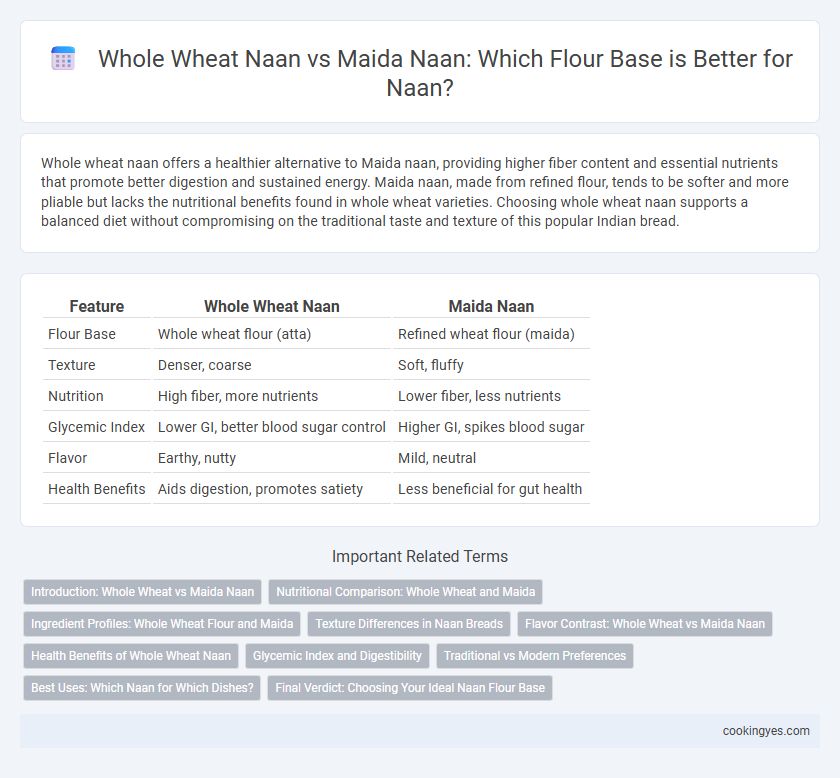Whole wheat naan offers a healthier alternative to Maida naan, providing higher fiber content and essential nutrients that promote better digestion and sustained energy. Maida naan, made from refined flour, tends to be softer and more pliable but lacks the nutritional benefits found in whole wheat varieties. Choosing whole wheat naan supports a balanced diet without compromising on the traditional taste and texture of this popular Indian bread.
Table of Comparison
| Feature | Whole Wheat Naan | Maida Naan |
|---|---|---|
| Flour Base | Whole wheat flour (atta) | Refined wheat flour (maida) |
| Texture | Denser, coarse | Soft, fluffy |
| Nutrition | High fiber, more nutrients | Lower fiber, less nutrients |
| Glycemic Index | Lower GI, better blood sugar control | Higher GI, spikes blood sugar |
| Flavor | Earthy, nutty | Mild, neutral |
| Health Benefits | Aids digestion, promotes satiety | Less beneficial for gut health |
Introduction: Whole Wheat vs Maida Naan
Whole wheat naan offers higher fiber content and more nutrients compared to maida naan, which is made from refined flour with a lighter texture and softer bite. The glycemic index of whole wheat naan is lower, making it a better choice for blood sugar management. Flavor profiles differ, with whole wheat naan presenting a nuttier taste, while maida naan delivers a mildly sweet and delicate flavor.
Nutritional Comparison: Whole Wheat and Maida
Whole wheat naan contains higher fiber content and essential nutrients such as vitamins B-complex and minerals compared to maida naan, which is made from refined flour with fewer nutrients and lower dietary fiber. The glycemic index of whole wheat naan is lower, promoting better blood sugar control and sustained energy release. Choosing whole wheat naan supports improved digestion and overall metabolic health due to its unprocessed grain composition.
Ingredient Profiles: Whole Wheat Flour and Maida
Whole wheat naan uses whole wheat flour, which contains bran, germ, and endosperm, offering higher fiber content, essential nutrients, and a more complex flavor profile. Maida naan is made from refined white flour (maida), stripped of bran and germ, resulting in a softer texture but lower dietary fiber and micronutrients. The ingredient profile of whole wheat flour provides better glycemic control and more antioxidants compared to maida, making it a healthier choice for naan bases.
Texture Differences in Naan Breads
Whole wheat naan features a denser, chewier texture due to its higher fiber content, offering a hearty bite and richer mouthfeel. Maida naan, made from refined flour, boasts a softer, fluffier texture with a light and airy crumb, making it more pliable and ideal for wrapping fillings. The difference in gluten development between whole wheat and maida flour significantly influences the tenderness and elasticity of the naan bread.
Flavor Contrast: Whole Wheat vs Maida Naan
Whole wheat naan offers a robust, nutty flavor profile with a denser texture that appeals to those seeking a wholesome, earthy taste. Maida naan, made from refined white flour, features a soft, pillowy consistency with a subtle sweetness and lighter flavor, making it a popular choice for pairing with rich curries. The flavor contrast between whole wheat and maida naan highlights the former's hearty character versus the latter's delicate, airy quality, influencing the overall dining experience.
Health Benefits of Whole Wheat Naan
Whole wheat naan, made from whole grain flour, retains bran, germ, and endosperm, providing higher fiber, vitamins, and minerals compared to maida naan, which uses refined flour stripped of these nutrients. The increased fiber content in whole wheat naan aids digestion, supports weight management, and helps stabilize blood sugar levels. Choosing whole wheat naan over maida naan contributes to better cardiovascular health and reduced risk of chronic diseases due to its nutrient density and lower glycemic index.
Glycemic Index and Digestibility
Whole wheat naan has a lower glycemic index (GI) ranging from 50 to 70, making it a better option for blood sugar control compared to maida naan, which typically has a higher GI around 70 to 85. Whole wheat flour contains more fiber and nutrients, enhancing digestibility and promoting slower carbohydrate absorption. Maida naan, made from refined flour, lacks fiber, leading to quicker digestion and a sharper spike in blood glucose levels.
Traditional vs Modern Preferences
Whole wheat naan offers a traditional, nutrient-rich alternative to maida naan, incorporating higher fiber and essential minerals favored in authentic Indian cuisine. Modern preferences often lean towards maida naan for its softer texture and lighter taste, popular in contemporary restaurants and fast food settings. The choice between whole wheat and maida reflects cultural shifts, balancing health consciousness with culinary indulgence in flour selection.
Best Uses: Which Naan for Which Dishes?
Whole wheat naan offers a denser texture and nuttier flavor, making it ideal for pairing with hearty dishes like lentil dal or spiced vegetable curries. Maida naan, made from refined flour, is softer and fluffier, complementing rich, creamy gravies such as butter chicken or paneer makhani. Choosing between whole wheat and maida naan depends on the desired texture and the richness of the accompanying dish.
Final Verdict: Choosing Your Ideal Naan Flour Base
Whole wheat naan offers a higher fiber content and more nutrients compared to maida naan, which uses refined flour and has a softer texture with a milder taste. Choosing your ideal naan flour base depends on dietary preferences; whole wheat naan supports better digestion and a richer flavor profile, while maida naan excels in softness and neutrality, making it adaptable to various dishes. For a health-conscious choice, whole wheat is optimal, whereas maida remains preferred for traditional softness and tenderness.
Whole wheat naan vs Maida naan for flour base Infographic

 cookingyes.com
cookingyes.com